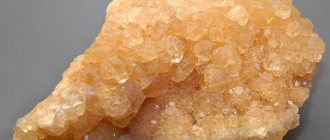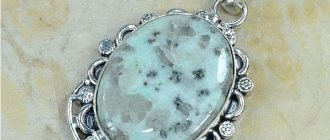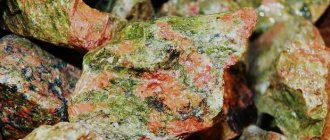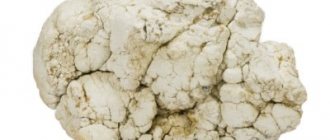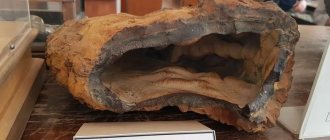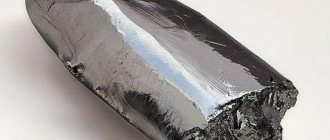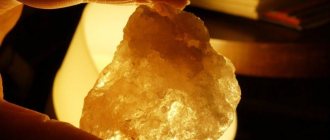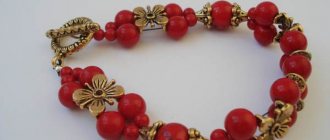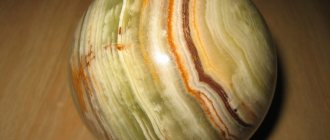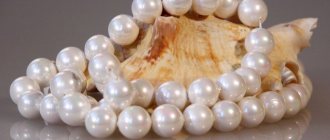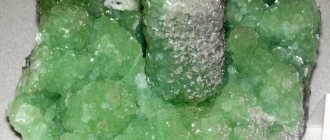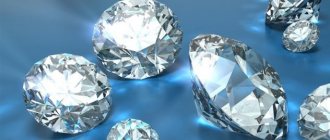Sepiolite was first mentioned in sources dating back to the 4th century BC as a mineral discovered in the Kilcad Islands, which is still mined in the area. It can also be found under names such as meerschaum or keffekil.
Its main value lies in the fact that the structure of the mineral is ideal for the smallest carvings: figurines and amulets of the finest handcraft are made from it, and smoking pipes made of sepiolite are known all over the world.
Chemical composition
{Mg8-3xFe2x(H2O)4 (OH)4 [Si12O30] ∞∞ } • (H2O)4
Often, according to chemical analysis calculations, Mg in the formula must be partially replaced by H. The water content fluctuates greatly. A significant part of the water is removed by drying and heating to 300°. In the range between 300 - 400o there is a change in the crystal lattice, and at 750o disorganization of the crystal lattice occurs. Depending on the amount of H2O, the content of SiO2 (from 52 to 60%) and MgO (from 21 to 27%) also fluctuates. Among the impurities, NiO is often present. Sepiolite with a higher Mg content, which can be partially replaced by Ni2+ (up to 7.6% NiO in Ni-sepiolite), Fe2+ (up to ~ 2% FeO); the M3+ content reaches 2.4 FU, ferrisepiolite with Fe3+ ≤ 0.8 FU (~9% Fe2O3) is known, the Ca content is usually lower, and Na and K are higher (up to ~1 FU each) than in palygorskite. The content of CaO, CO2 and other components is due to mechanical impurities.
Crystallographic characteristics
Crystal structure
The structure of the mineral is similar to the structure of amphiboles, but differs in the presence of water molecules located between the networks of silicon-oxygen tetrahedra and a triple chain of silicon-oxygen tetrahedra; in connection with this, the structure forms a new radical [Si12O30] and is to some extent intermediate between the structures of chain and sheet silicates.
Mg, Al and the Fe2+, Fe3+ that replace them are included in the cationic octahedra of brucite (gibbsite) ribbons, Ca, K, Na - into the channels of the framework, which acquires a negative charge due to vacancies in brucite (gibbsite) ribbons. Depending on the relative position of adjacent tetrahedral networks, 16 structural varieties of palygorskite and sepiolite of the orthorhombic, monoclinic and triclinic system were derived. Natural palygorskite more often turned out to be of the mononoclinic system (P2/m), sepiolite - orthorhombic system (Pnсn). The existence of mixed minerals is allowed.
Stone care
Having become the owner of a figurine, decoration or household item made from sepiolite, you should know the rules for handling such a product:
- You cannot expose its surface to prolonged exposure to water, as the stone in water becomes plastic and may lose its shape and color;
- Keffekil gets dirty easily and is quite difficult to wash, so it is necessary to minimize the possibility of contamination of the product;
- Due to its porous structure, the stone easily crumbles and breaks.
By following these simple rules, you can enjoy the natural beauty of sepiolite stone for a long time.
Form of meerschaum found in nature
Aggregates. Solid clay-like masses (especially in sepiolite), becoming creamy when moistened, but not swelling with water and not plastic, porcelain-like after drying. Under an electron microscope, a fine fibrous structure is revealed. Often matted fibrous, felt-like or leather-like masses, paper-thin sheets, films, crusts. Hence the synonyms: meerschaum .
Inclusions can be very abundant: calcite or dolomite, partly with silica. In Morocco, potassium and magnesium sulfates are found as inclusions.
Production (field)
Hydrated magnesium silicate is overwhelmingly mined in Turkey, where it has been used as soap since ancient times. Today Turkey is the main supplier of the highest quality sepiolite, which is used in the creation of the well-known smoking pipes. But it is found not only there; the presence of meerschaum has been recorded in various climatic zones:
| A country | Terrain |
| Russia | Tatarstan |
| Murmansk region (Kola Peninsula) | |
| Crimea | |
| Ural Southern | |
| Ural Middle | |
| Siberia | |
| Yakutia | |
| Ukraine | Kirov |
| Kazakhstan | Kustanay |
| middle Asia | Uzbekistan |
| USA | Texas |
| Africa | Tanzania |
Physical properties of sepiolite
Optical
- Color. Ferrisepiolite - brown, Ni-sepiolite - apple green, bluish green.
- The line is white
- The shine is dull to waxy.
- Transparency Becomes more transparent when immersed in liquid.
Mechanical
- Hardness 2-2.5
- Density 2 Dry porous masses float in water in most cases.
- The fracture is smooth to fibrous (porcelain-like discharge), unevenly fibrous (mountain leather).
- Solid clay-like masses are viscous, fibrous, leathery, flexible, but not elastic, durable.
Chemical properties
Sepiolite completely decomposes in the cold from HCl (10%) after 12-48 hours; the degree of decomposition decreases as the Al content increases. White, grayish sepiolite in a 5% aqueous solution of methyl orange becomes purple; palygorskite does not change color.
Diagnostic signs
Similar minerals. Kaolinite.
Associated minerals. Opal, magnesite, dolomite.
Meerschaum is compact and smooth to the touch. Sepiolite resembles kaolinite or thin sericite, but with less light refraction. It differs from asbestos in its tangled fibrous structure, often in paragenesis. In finely dispersed masses, they are macroscopically difficult to distinguish from other clay minerals.
Scope and scope
Meerschaum is used in various areas of human life:
- During the construction of chimneys;
- In the thermal insulation industry;
- As an absorbent for all kinds of fillers;
- As a substitute for soap and cleaning products;
- In jewelry and souvenir production.
Decorations
Sepiolite is incredibly easy to process and polish: that is why it is so in demand among jewelers and souvenir makers. With its help, world-famous smoking pipes of the finest handcraft are made. Despite the fact that such products are a relic of the past, they do not cease to be popular in the collecting world. At auctions you can find unique samples, valued at round sums: from 30 thousand rubles. and higher.
No less famous are Turkish thimbles and figurines made from keffekil: the unique jewelry carving will not leave even the most sophisticated collector indifferent.
Sepiolite deposits
Palygorskite and sepiolite are known from the weathering crusts of serpentinites in the Urals. In many carbonate, especially magnesian-carbonate sedimentary rocks, silicified layers in them, in oolitic iron ores, sandy-siltstone rocks. Sepiolite plays a significant role in some clays. The mineral was established in the same place in bottom clays. They are common minerals in many soils.
Sepiolite with fiber lengths up to 8 cm in close association with pyrite - at the Rudnogorsk magnetite deposit (Irkutsk region), ferrisepiolite in the form of a dike 30-150 cm thick, developed due to plagioclase porphyrites - in the Ankan region (Eastern Hokkaido, Japan). Meerschaum was found in significant masses in alluvial clay products of the destruction of ultramafic rocks at the foot of the mountain in the Eski Sher plain (Turkey).
Areas of application
The mineral has found wide application in various industries:
- the rheological properties of sepiolite are not affected by high temperatures, therefore it is widely used in the drilling industry, where drilling fluids used in deep wells are made from it,
- in pharmacy and the household sector it is used as an absorbent; sepiolite is often used to clean water surfaces from oil products, in the production of animal fillers,
- the mineral is used in ornamental work in the manufacture of thimbles, jewelry, souvenirs,
- its absorbent properties formed the basis of smoking pipes, ensuring the absorption of nicotine tars,
- The rock is in demand in the production of thermal insulating building materials and building mixtures.
Sepiolite or meerschaum - history, useful properties and description of the stone
SEPIOLITE is a mineral, a type of talc, snow-white in color, very light, so that when thrown into water, it floats on it for the first time; located in Greece and Asia Minor; in ancient times it was used for making vessels, now pipes are made from it. Otherwise called... ... Dictionary of foreign words of the Russian language
sepiolite - noun, number of synonyms: 1 • mineral (5627) ASIS Dictionary of Synonyms. V.N. Trishin. 2013 ... Dictionary of synonyms
SEPIOLITE - clayey ml gr. palygorskite with a layered but chain-like structure Mg4[(OH)2|Si6O15 ·2Н2О + 4H2O·Mg is replaced by Fe2+ and Fe3+. Its properties are similar to palygorskite. Various: ferrisepiolite, aluminosepiolite, nickelsepiolite, parasepiolite. Sin.:... ...Geological encyclopedia
sepiolite - sepiolitas statusas T sritis chemija apibrėžtis Molio mineralas. formulė Mg₄[(OH)₂|Si₆O₁₅]·6H₂O atitikmenys: engl. sepiolite rus. sepiolite … Chemijos terminų aiškinamasis žodynas
Sepiolite - (from Sepia and Greek líthos stone: named for its resemblance to the porous calcareous skeleton of the sepia cuttlefish) gunnbjarnite, a clay mineral from the class of silicates (See Silicates) with a complex, chain-layered structure. Chemical composition... ... Great Soviet Encyclopedia
Sepiolite is a mineral; see Meerschaum ... Encyclopedic Dictionary F.A. Brockhaus and I.A. Ephron
sepiolite (meerschaum) - Mineral (hydroxymagnesium silicate); dense massive formations are used as ornamental stone. [English-Russian gemological dictionary. Krasnoyarsk, KrasBerry. 2007.] Topics: gemology and jewelry production EN sepiolite ... Technical Translator's Guide
Agglomerated sepiolite - is obtained by agglomerating fragments and other waste of natural sepiolite with binding agents (oil, alum, etc.) under the influence of heat. They are included here only when in the form of plates, rods, sticks or the like... ... Official terminology
Natural Sepiolite - 1. Natural sepiolite is a very light and porous hydrated magnesium silicate, white, yellowish, gray or pink, found exclusively in Asia Minor. It is mined in small pieces (its sides rarely exceed 30 cm). These pieces... ... Official terminology
Penka - Sepiolite Tourist rug Penka (tributary of the Varzina) Penka (tributary of the Vokhtoma) ... Wikipedia
Cases today
These conditions occur many times in Australia. When this happens, the beaches are covered with foam for quite some time. This foam is caused by excess organic pollutants. If we compare the Galician body foam with the Australian foam, we can see that the appearance is different. While Galicia seems more natural, the one in Australia looks like foam when we look at the washing machine during washing.
Interestingly, there is a mineral in the world known as sea foam. This name was given because of its white color and resemblance to foam. Previously, this mineral was used to make smoking pipes. S e is a type of sepiolite and is very useful in marine oil spills. This is due to its high absorbent properties, which can hold most of the spill and then recover it. It's like spilling something on the floor with a sponge to soak up the liquid. It also helps that this oil does not reach the seabed, causing damage to the flora and fauna present.
As you can see, sea foam has its own origin and explanation. This way, the next time you go to the beach and you see that there is a lot of foam in the sea, you will be able to better understand what is causing it.
All about eudialyte: description and properties of the stone, application and interesting facts
A rare beautiful stone of northern latitudes, eudialyte has a unique structure and properties. His middle name and origin are accompanied by a beautiful legend of the ancient people. The play of colors in jewelry makes you fall in love with the mineral at first sight.
Description and cost of eudialyte
Eudialyte is a stone that in mineralogy belongs to the group of silicates. Synonym: almandine spar. The name goes back to ancient Greek roots: eu - “good”, dialitos - “decomposable”, that is, well decomposed, easily soluble.
The mineral also has a more poetic name - Lapp or Sami blood.
The rock is characterized by shades of red, while the appearance of the stone resembles a garnet. There are also purple, brown, yellow-brown specimens.
Depending on the deposit and color, several subspecies of eudialyte are distinguished.
- Barsanovit - Khibiny massif, tones from red-brown to rare yellow-green.
- Eucolite - Norwegian deposits, dark colors predominate due to iron oxide.
- Ikranite - dumps of the Lovozero massif, the mineral is found in the form of yellow grains.
- Rastsvetaevit - Khibiny massif, reddish-pink shades.
Prices for shiny picturesque stone:
- cabochon - from 270 rubles;
- jewelry - from 3000 rubles;
- balls - from 9,000 rubles.
The video shows the processed gem:
Deposits and historical facts about the mineral
Eudialyte is not very common in nature. The main deposits of igneous origin are located in northern latitudes:
- Lovozero and Khibiny massifs on the Kola Peninsula;
- Northern Europe;
- northern USA;
- Canada;
- Greenland.
It was possible to obtain an analogue of a natural mineral artificially under the influence of certain conditions. It is synthesized at a temperature of 450–550 degrees, water vapor pressure of 85–700 kgf/cm2.
The history of the stone is accompanied by interesting facts and legends. The mineral has long been known and valued by the indigenous inhabitants of Lapland, the Sami, or Lapps. According to their legend, many brave Sami warriors died defending their native land from the treacherous Swedes under the leadership of the giant Kuiva.
The attack was repelled, and the blood of the dead heroes turned into bright eudialyte, reminding descendants of the struggle of the courageous Lapps for independence.
A German pharmacist-chemist named the stone based on its chemical properties. True, at the beginning of his work he called eudialyte red leafy garnet.
In 1890, Wilhelm Ramsay, a professor at the Imperial Alexander University, published descriptions of nine minerals that were discovered as a result of research into the Lovozero massif in the journal Fennia. Among the new stones was eudialyte. For his research on the Kola Peninsula, the geologist was awarded the Alexander II Prize.
We recommend that you familiarize yourself with the legend of the stone in the following video:
Properties and uses of stone
Rarely found, eudialyte is even more rarely formed in the form of crystals, so the mineral is not so widely distributed among jewelers. In industry, the stone is used to obtain rare earth metals, as zirconium ore.
Physicochemical characteristics
The chemical formula of eudialyte is Na4(Ca, Fe, Ce, Mn)2ZrSi6O18(OH, Cl). It is a complex silicate of calcium, sodium, zirconium. Typical impurities include: potassium, titanium, strontium, magnesium, niobium.
As a representative of alkaline rocks, the stone is completely soluble in acids. With a high concentration of strontium in the composition, the mineral becomes radioactive.
Eudialyte has a unique crystal structure that is not found in any other rock. Its frame consists of three rings, in the cavities of which anionic groups, cations of various sizes, and water molecules are located. In the center of the rings there are two “traps”, tri- and quadrangular, for cations. Vast voids are occupied by water particles, anions, and large cations.
- formed in the form of granular masses;
- has a glassy luster;
- has translucent transparency;
- brittle, hardness on the Mohs scale - 5.5 points;
- density – about 3 g/cm3;
- Easily processed by polishing.
Healing and magical properties of eudialyte
Sami healers have long turned to eudialyte to cure diseases.
- With its help, the circulatory system was cleansed. They knew about its positive effect on the functioning of the heart.
- To treat diseases of the pancreas and prevent pancreatitis, lithotherapists still recommend wearing the mineral on your stomach.
- By influencing the heart chakra, it relieves depression and helps cope with melancholy and melancholy.
- Daily eye exercises with contemplation of the stone tone the visual muscles, reducing intraocular pressure and improving vision.
However, given the weak radioactivity of the mineral, it is better to wear products with it away from moles and the thyroid gland. You should not interact with eudialyte constantly.
Eudialyte is the best amulet for the brave.
The amulet saves brave warriors from wounds and injuries. A talisman made from eudialyte is indicated for everyone whose profession involves risk to life. In addition, the stone protects the owner from the negative thoughts of bad people.
Psychics use eudialyte balls to enhance their abilities. It is believed that the mineral promotes clairvoyance, causes prophetic dreams, and reveals new levels of consciousness.
There is an opinion among initiates that the gem enhances the effect of other minerals that are adjacent to it. When choosing a pair for eudialyte, you should remember that not only the positive qualities of the crystals become stronger, but also the negative ones.
Suitable for people born under the zodiac signs of the earth element:
- It will help Virgo women to quickly cope with life’s troubles, get rid of sadness, sadness and despondency;
- for Virgo men it will add self-confidence, give strength, and save them from dangers;
- It will make Capricorns and Taurus more purposeful, decisive, and persistent.
Watch the webinar about the properties of the mineral:
Products and decorations with eudialyte
In stone cutting, the mineral is used to make:
- souvenirs;
- figurines;
- balls;
- candlesticks;
- writing instruments;
- ashtrays
Despite the fact that the stone is rarely found in the form of crystals, it is used for making jewelry. Grained arrays are processed into cabochons and used as inserts for rings, brooches, earrings, and pendants. The method best reveals the color combinations of inclusions and impurities.
Paired stones consisting of two minerals of different colors, such as red eudialyte and white apatite, look very impressive. Such cabochons are in great demand.
A soft stone requires a setting. Usually the jewelry is framed in silver. A good addition to the product would be beads or small beads. For women, a stone bracelet in white metal is recommended; for men, a rosary or keychain is recommended.
“Sea foam” - there is such a mineral
Sea Foam (or Sepiolite) is a rare mineral. The only deposit in the world is located in Turkey. The mineral is prohibited from being exported as a raw material outside the country. It crosses the border only in the form of finished products.
Sea foam is used primarily to make women's jewelry and smoking pipes. Sea foam is a good absorbent, which is why smokers appreciate these properties of Sepiolite.
Sepiolite has a density of 2.26 g/cu.m. The mineral has a very porous structure and, like pumice, contains a lot of air, which can reduce its density so much that it floats on water. Before drying, seafoam tubers are soft and greasy to the touch. When in contact with water it foams like soap and this property was used by the Greeks and Turks to cleanse the body as a cleanser.
It is an excellent material for making souvenirs as it is easy to work with due to its porous structure. The fact that it is absorbent makes it preferable to all other materials as a filter for water purification.
The old name “sea foam” comes from the widespread belief that the birth of the mineral is associated with sea foam. The color of the mineral is white, sometimes with a yellow or gray-pink tint.
The geological origin of sea foam is not entirely clear. It is magnesium silicate, consisting of 63.3% silicon dioxide, 27.4% magnesium oxide and 9.3% water. The ancient Greeks believed that this was the frozen foam from which Aphrodite was born. The mineral was credited with rejuvenating properties.
One version suggests that “sea foam” is formed from deposits of fossil shells and fish cartilage, which is why in 1847 the mineral received its second name - sepiolite. The name comes from the Greek word sepion, meaning the mineral bones of fish.
Shells (Sea shells)
Turkish mineralogists, however, adhere to a different theory: the Sakarija River has repeatedly changed its course, and near the current village of Killtischik it is slowed down by magnesium rocks. This obstacle was an accumulation over thousands of years, and was associated with the liming of silt in the river bed. These sinking particles settled gradually in areas with slow flow. Subsequent landslides covered these mineral layers and stored them for millions of years, giving sea foam its current consistency.
Near the city of Eskisehir, between Istanbul and Ankara, the main deposit and production of white meerschaum is located.
Why is sea foam white?
List of rivers of Turkey
Anecdote of a sparkling day
Because we mentioned the temperature, there is an anecdote that happened in 2014 on the day of the retes in Galicia. The waves reached a height of about 10 meters, so the wind was blowing making it very strong. To such an extent that the waves were very strong, the sea was rough and the temperature was very low that the amount of sea foam released covered several tens of kilometers.
Although it's just foam, the event produced some beautiful sunsets and quite a beautiful event. If it had been at a much higher ambient temperature, this would not have happened. , since the gases that make up the bubbles would have escaped into the atmosphere much earlier due to the effects of temperatures. Let's not forget that warmer air is less dense, so it tends to rise and be replaced by cooler air.
Sepiolite or meerschaum - history, useful properties and description of the stone
SEPIOLITE is a mineral, a type of talc, snow-white in color, very light, so that when thrown into water, it floats on it for the first time; located in Greece and Asia Minor; in ancient times it was used for making vessels, now pipes are made from it. Otherwise called... ... Dictionary of foreign words of the Russian language
sepiolite - noun, number of synonyms: 1 • mineral (5627) ASIS Dictionary of Synonyms. V.N. Trishin. 2013 ... Dictionary of synonyms
SEPIOLITE - clayey ml gr. palygorskite with a layered but chain-like structure Mg4[(OH)2|Si6O15 ·2Н2О + 4H2O·Mg is replaced by Fe2+ and Fe3+. Its properties are similar to palygorskite. Various: ferrisepiolite, aluminosepiolite, nickelsepiolite, parasepiolite. Sin.:... ...Geological encyclopedia
sepiolite - sepiolitas statusas T sritis chemija apibrėžtis Molio mineralas. formulė Mg₄[(OH)₂|Si₆O₁₅]·6H₂O atitikmenys: engl. sepiolite rus. sepiolite … Chemijos terminų aiškinamasis žodynas
Sepiolite - (from Sepia and Greek líthos stone: named for its resemblance to the porous calcareous skeleton of the sepia cuttlefish) gunnbjarnite, a clay mineral from the class of silicates (See Silicates) with a complex, chain-layered structure. Chemical composition... ... Great Soviet Encyclopedia
Sepiolite is a mineral; see Meerschaum ... Encyclopedic Dictionary F.A. Brockhaus and I.A. Ephron
sepiolite (meerschaum) - Mineral (hydroxymagnesium silicate); dense massive formations are used as ornamental stone. [English-Russian gemological dictionary. Krasnoyarsk, KrasBerry. 2007.] Topics: gemology and jewelry production EN sepiolite ... Technical Translator's Guide
Agglomerated sepiolite - is obtained by agglomerating fragments and other waste of natural sepiolite with binding agents (oil, alum, etc.) under the influence of heat. They are included here only when in the form of plates, rods, sticks or the like... ... Official terminology
Natural Sepiolite - 1. Natural sepiolite is a very light and porous hydrated magnesium silicate, white, yellowish, gray or pink, found exclusively in Asia Minor. It is mined in small pieces (its sides rarely exceed 30 cm). These pieces... ... Official terminology
Penka - Sepiolite Tourist rug Penka (tributary of the Varzina) Penka (tributary of the Vokhtoma) ... Wikipedia
